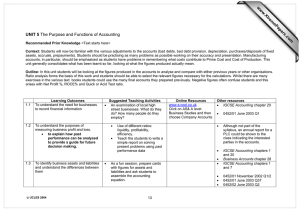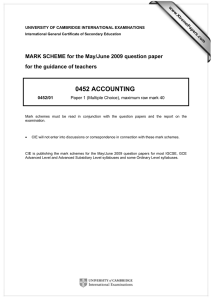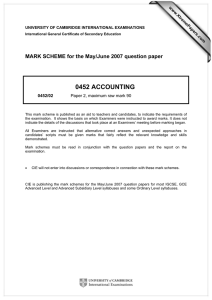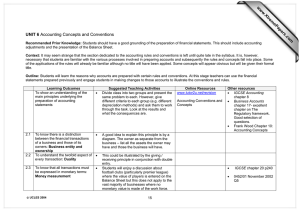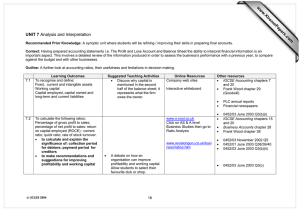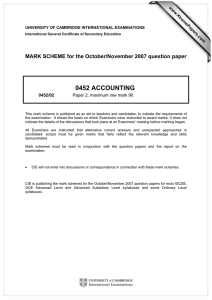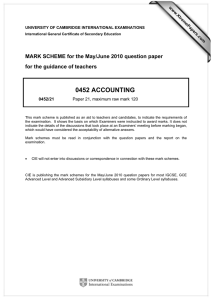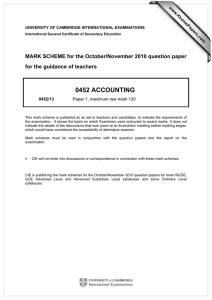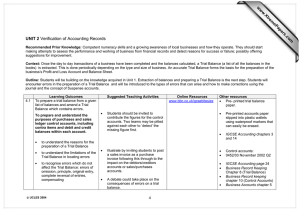0452 ACCOUNTING - IGCSE Accounts
advertisement
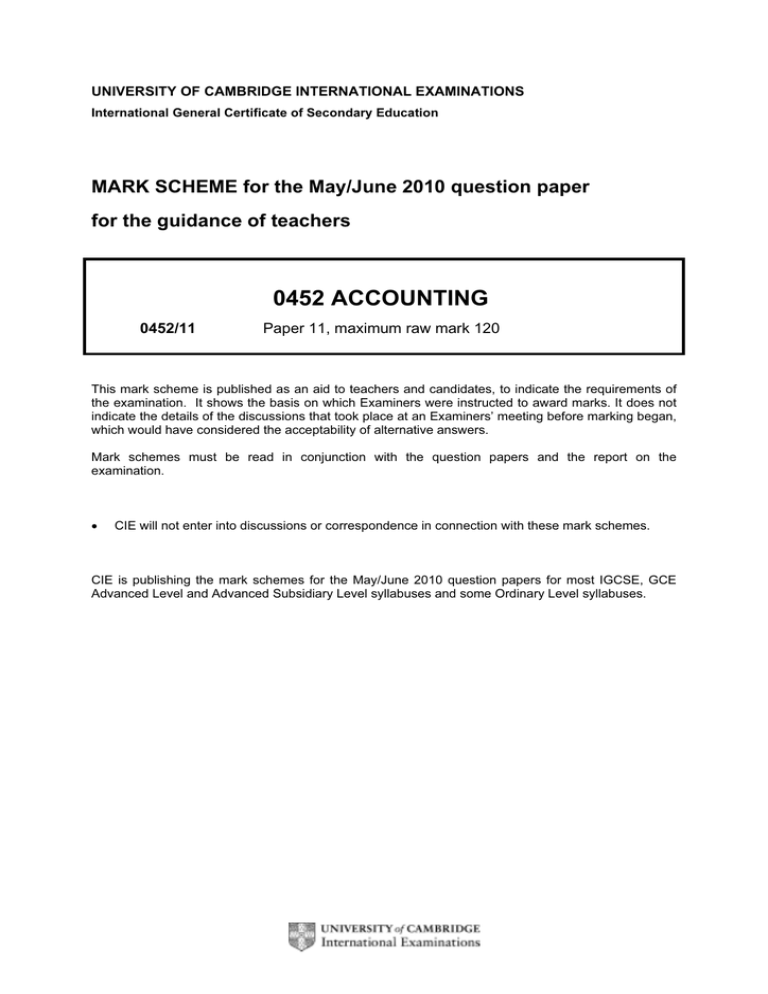
UNIVERSITY OF CAMBRIDGE INTERNATIONAL EXAMINATIONS International General Certificate of Secondary Education MARK SCHEME for the May/June 2010 question paper for the guidance of teachers 0452 ACCOUNTING 0452/11 Paper 11, maximum raw mark 120 This mark scheme is published as an aid to teachers and candidates, to indicate the requirements of the examination. It shows the basis on which Examiners were instructed to award marks. It does not indicate the details of the discussions that took place at an Examiners’ meeting before marking began, which would have considered the acceptability of alternative answers. Mark schemes must be read in conjunction with the question papers and the report on the examination. • CIE will not enter into discussions or correspondence in connection with these mark schemes. CIE is publishing the mark schemes for the May/June 2010 question papers for most IGCSE, GCE Advanced Level and Advanced Subsidiary Level syllabuses and some Ordinary Level syllabuses. Page 2 Mark Scheme: Teachers’ version IGCSE – May/June 2010 Syllabus 0452 Paper 11 MARKING GUIDELINES • Award marks only in accordance with the mark scheme. • Where a candidate makes an arithmetical error or selects the wrong figure in an account or a calculation, so that totals or the results of the calculation are wrong but are correct on his own figures, he will lose the mark for selecting the original figure but may earn an own figure (OF) mark for the result, total or calculation. • Where particular wording is shown on the mark scheme accept any reasonable spelling and abbreviation as long as the meaning is clear. For example, for “Balance brought down” accept Balance b/down, Balance b/d, Balance, Bal b/down, Bal b/d, Bal, Brought down, b/down, b/d, but not Bbd, bd, or any variation of “Balance carried down”. • Where a ledger account is to be prepared, each mark is usually for the date, narrative and amount together. If the candidate has correctly prepared the account but not shown some or all of the dates he may earn some marks according to the mark scheme. • If a ledger account is completely reversed no marks will be awarded for individual entries but there may be marks available for own figure balances carried and brought down • Where an answer is to be shown as a ratio, it should be shown as xx:1 and not as 1:xx. An answer of just the correct figure xx may be accepted but not if any other description such as %, times, days etc is shown and not if shown as negative when it should be positive. • Where a calculation is to be shown to two decimal places, an answer rounded up or down may be accepted (e.g. 2.85 or 2.86 if the true answer is 2.853) but not an answer shown to only the nearest whole number or one decimal place (e.g. 2.8 or 3). • Where dollars and cents are shown in a question and exact cents are required in a calculated answer (e.g. $35.60) many candidates will show $35.6 as their calculators will suppress the final 0. Although wrong this may be accepted. The $ sign is not required. • Ledger accounts may be accepted in either two sided or the running balance format and the mark scheme will show how marks should be allocated. • Where a final account is requested, a list of items will not normally earn any marks. • If candidates are required to prepare a Balance Sheet, either a two sided or a vertical presentation will be accepted and the mark scheme will show how marks are to be awarded. © UCLES 2010 Page 3 1 Mark Scheme: Teachers’ version IGCSE – May/June 2010 Question Number (a) (b) (c) (d) (e) Syllabus 0452 Question Number Key C D B B C (f) (g) (h) (i) (j) Paper 11 Key D B C A D [Total: 10] 2 (a) Property (Land and buildings)(only one mark) Fixtures and fittings Plant and equipment (machinery)(only one mark) Office equipment Motor vehicles Any two [2] (b) Sales returns account Debit entry (1) Credit entry [1] (c) Consistency [1] (d) Net book value = Cost (1) less accumulated depreciation (1) [2] (e) Income statement (Trading and profit and loss account) (must include the word “trading”) [1] (f) Accruals (matching), not prudence [1] (g) (i) Percentage of gross profit to sales = (75 000 (1) – 52 500 (1)) / 75 000 (1) × 100% = 30.00% (1)OF [4] (ii) Percentage of net profit to sales = (22 500 (1)OF – 7 500 (1)) / 75 000 (1) × 100% = 20.00% (1)OF = $5 000 (1) / $0.50 = 10 000 (1) = 10 000 × $0.15 (1) = $1 500 (1)OF (For 5000 (1) × 0.50 × 0.15 (1) = 375, award 2 marks as shown) [4] (h) Number of shares Total dividend [4] [Total: 20] © UCLES 2010 Page 4 3 Mark Scheme: Teachers’ version IGCSE – May/June 2010 (a) Syllabus 0452 Paper 11 Sumaru Cash book, April 2010 April 3 9 12 22 28 Cash Dr $ Ahar Cash sales Bannu Dooly Eduardo Bank Dr $ 1 500 (1) (1)* (1)* 4 000 (1) (1)* 2 000 (1) (1)* 1 650 (1) (1)* 900 (1) *Mark is for date and name [10] (b) Name of account Dr $ Cr $ 4000 (1) Sales (1) (accept cash sales but not sales ledger) [2] (c) Date 30 April Dr 360 (1) Cr Suspense (1) Cash book (bank) (1) 360 (1) To correct balance entered at 1 April 2010 (1) (Award marks for amount only if correctly shown as Dr or Cr with account name.) (d) Send statement Offer cash discount (not trade discount) Limit credit (no more credit sales) Charge interest on overdue amounts Use debt collection methods [5] (any two, 2 marks each) [4] [Total: 21] © UCLES 2010 Page 5 4 Mark Scheme: Teachers’ version IGCSE – May/June 2010 Syllabus 0452 (a) (i) Lower (1) of cost (1) and net realisable value (1) Paper 11 [3] (ii) $2 700 (1) [1] (iii) Reduces profit (not overstated or understated) (1) by $300 (1) [2] (b) Timpani Limited Balance Sheet at 31 March 2010 $ Non-current (fixed) assets Plant and equipment at cost Accumulated depreciation Net book value $ 20 000 (1) 12 000 (1) 8 000 (1) Current assets Inventory (stock) Trade receivables (debtors) Bank 2 700 (1) 1 000 (1) 500 (1) 4 200 Current Liabilities Trade payables (creditors) Bank loan (must be shown as current liability) 700 (1) 2 800 (1) 3 500 Net current assets Total assets 700 8 700 Equity Share capital Profit for the year 5 000 (1) 3 700 (2) 8 700 Note: award marks for acceptable layout, not list of balances. [11] (c) Reduce dividend Reduce depreciation Reduce trade payables (creditors) Successful (2) Not Successful (2) (2) [6] (d) (i) Going concern (1) (ii) Expected sale values (2) (accept net realisable value) [3] [Total: 26] © UCLES 2010 Page 6 5 Mark Scheme: Teachers’ version IGCSE – May/June 2010 Syllabus 0452 Paper 11 (a) Capital Hire charges Cash discount received from motor dealer for prompt payment for new car Part exchange value of used car Revenue (2) (2) (2) [6] (b) (i) Cost $12 000 (1) @ 30% (1) = $3 600 (1)OF [3] (Award only the component marks but not the mark for $3600 if other calculations are shown, e.g. net book value or for other years.) (ii) Net book value = $8 400 (1)OF (Award this mark if correct by reference to answer to (i).) [1] (c) 2010 April 1 Motor vehicle* Disposal of motor vehicles $ 2010 $ 12 000 (1) April 1 Depreciation* 3 600 (1) Bank (Insurance) 5 000 (1) Income statement 3 400 (2)OF (Profit & loss account) 12 000 12 000 (Mark is for reasonable narrative and amount, not date.) (*Award 2 marks for “Net book value 8400”, but 0 for “Balance b/down 8400”.) (d) (i) The rate may be too low as large loss arose on scrapping car. An increased rate, up to 60%, would reduce loss. (Award marks for similar comments.) (ii) Straight line method (1) over life of car, or using scrap value (1) or Based on estimated mileage over three years (2) or other reasonable suggestion and explanation. [5] [2] [2] [Total: 19] © UCLES 2010 Page 7 6 Mark Scheme: Teachers’ version IGCSE – May/June 2010 (a) Syllabus 0452 $ 15 270 2 680 12 590 4 080 16 670 3 140 13 530 Deposits to bank Less: cash sales Add: receivables at 31/3/10 Less: receivables at 1/4/09 Credit sales Paper 11 (1) (1) (1) (1) (1)OF (Award total figure only if no aliens, e.g. cash book balance b/fwd shown.) (b) Wilma Trading account for the year ended 31 March 2010 $ Revenue (sales) – credit – cash Inventory (stock) at 1 April 2009 Purchases Carriage inwards 1 780 9 560 280 11 620 1 920 Inventory (stock) at 31 March 2010 [5] $ 13 530 (1)OF 2 680 (1) 16 210 (1) (1) (1) (1) Cost of goods sold 9 700 (1)OF Gross profit 6 510 (1)OF (c) (i) Rate of inventory (stock) turnover = Cost of goods sold / average inventory (stock) = 9 700 (1)OF / [(1 780 + 1 920)/2 = 1 850 (1)OF] = 5.24 (1)OF times (1) (Note – a calculation mark may be awarded even if the formula is wrong.) (ii) Collection period for trade receivables (debtors) = (Debtors / credit sales) × 365 days = (4 080 (1) / 13 530 (1)OF) × 365 days = 110 (1)OF (accept 111) days (1) (Note – a calculation mark may be awarded even if the formula is wrong.) [8] [4] [4] (d) Increase Gross profit Percentage of gross profit to sales Rate of inventory (stock) turnover (1) Decrease (1) No change (1) [3] [Total: 24] © UCLES 2010 UNIVERSITY OF CAMBRIDGE INTERNATIONAL EXAMINATIONS International General Certificate of Secondary Education MARK SCHEME for the May/June 2010 question paper for the guidance of teachers 0452 ACCOUNTING 0452/21 Paper 21, maximum raw mark 120 This mark scheme is published as an aid to teachers and candidates, to indicate the requirements of the examination. It shows the basis on which Examiners were instructed to award marks. It does not indicate the details of the discussions that took place at an Examiners’ meeting before marking began, which would have considered the acceptability of alternative answers. Mark schemes must be read in conjunction with the question papers and the report on the examination. • CIE will not enter into discussions or correspondence in connection with these mark schemes. CIE is publishing the mark schemes for the May/June 2010 question papers for most IGCSE, GCE Advanced Level and Advanced Subsidiary Level syllabuses and some Ordinary Level syllabuses. Page 2 1 Mark Scheme: Teachers’ version IGCSE – May/June 2010 Syllabus 0452 Paper 21 (a) To remove small cash payments from the main cash book. To reduce the number of entries in the main cash book and the expenses in the ledger. To allow the chief cashier to delegate some of the work. Or other suitable reason. Any 2 reasons (1) each. [2] (b) The petty cashier starts each period with the same amount of money (1). At the end of the period the chief cashier will make up the cash remaining so that it is equal to the imprest amount (1). [2] (c) The chief cashier is aware of exactly how much is spent in each period. The cash remaining and the total of the vouchers received should always be equal to the imprest amount. Or other suitable advantage. Any 1 advantage (1). [1] (d) The petty cashier will receive $88. [1] (e) (i) Debit travelling expenses account with $11. [2] (ii) Debit N Jones account with $21 (2). Debit W Smith account with $18 (2). [4] (f) To spread the cost of fixed assets over their useful lives. To apply the accruals principle – recognising the time difference between payment for the fixed asset and its loss in value. To provide a more realistic view of the fixed assets. To record the loss in value of fixed assets – the part of the cost of the fixed asset consumed during the period of use. The annual depreciation charge represents the cost of using the fixed asset to earn revenue. Or other acceptable reason. Any 2 reasons (1). [2] (g) Where a choice of method is available, the one with the most realistic outcome should be selected and used consistently from one accounting period to the next. [2] © UCLES 2010 Page 3 Mark Scheme: Teachers’ version IGCSE – May/June 2010 Syllabus 0452 Paper 21 (h) (i) Straight line (equal instalment) method $ 8000 500 7500 Cost Less scrap value 7500 (1) = $2500 (1) 3 years (1) Annual depreciation [3] (ii) Reducing (diminishing) balance method Cost Depreciation for year ending 31 January 2011 (60% × 8000) Depreciation for year ending 31 January 2012 (60% × 3200) Depreciation for year ending 31 January 2013 (60% × 1280) $ 8000 4800 (1) 3200 1920 (1) 1280 768 (1) 512 [3] [Total: 22] © UCLES 2010 Page 4 2 Mark Scheme: Teachers’ version IGCSE – May/June 2010 Syllabus 0452 Paper 21 (a) To calculate how much it has cost the business to manufacture the goods produced in the financial year. [2] (b) Production did not meet demand. It was cheaper to buy the goods rather than make them. Those particular items could not be made by the business. Or other suitable reason. Any 2 reasons (1) each. (c) [2] Ahmed Zaki Manufacturing Account for the year ended 30 April 2010 $ Opening inventory (stock) of raw materials Purchases of raw materials 33 400 (1) 408 160 (1) 441 560 35 230 (1) 406 330 325 270 (1) 731 600 (1) Less Closing inventory (stock) of raw materials Direct factory wages Prime cost Factory overheads Indirect factory wages (130 200 + 1520) Factory general expenses (198 280 – 400) Depreciation factory machinery (162 000 + 19 500 – 150 000) Add Opening work in progress Less Closing work in progress Cost of production Horizontal format acceptable $ 131 720 (1) 197 880 (1) 31 500 (2) 361 100 1 092 700 14 200 1 106 900 13 900 1 093 000 (1)O/F (1) (1) (1)O/F [13] [Total: 17] © UCLES 2010 Page 5 3 Mark Scheme: Teachers’ version IGCSE – May/June 2010 Syllabus 0452 Paper 21 (a) Provision for doubtful debts 2½% × (15 530 – 90) (1) = $386 (1) (b) [2] Journal Debit Credit $ (i) Bad debts K Singh Bad debt written off $ 90 (1) 90 (1) (1) (ii) Income statement (profit and loss) Bad debts Transfer of total bad debts written off to income statement (profit and loss) (1) 300 (1) (iii) Income statement (profit and loss) Provision for doubtful debts Creation of provision for doubtful debts (1) 386 (1)O/F 300 (1) 386 (1)O/F [9] (c) Shilpa Gandhi Extract from Balance Sheet at 31 January 2010 Current Assets Trade receivables (trade debtors) Less Provision for doubtful debts $ 15 440 386 (1)O/F $ 15 054 (1)O/F [2] (d) Calculation of total value of inventory (stock) Type A 360 units × $23 per unit Type B (520 – 40) units × $12 per unit $ 8 280 (2) 5 760 (2) 14 040 (1)O/F [5] (e) Either Or Prudence Consistency [1] [Total: 19] © UCLES 2010 Page 6 4 Mark Scheme: Teachers’ version IGCSE – May/June 2010 Syllabus 0452 Paper 21 (a) (i) Mark-up is the gross profit measured as a percentage of the cost price. [1] (ii) Margin is the gross profit measured as a percentage of the selling price. [1] (b) (i) Cost of sales = (25 200 + 347 200) – 28 000 = 344 400 (1) Gross profit = 430 500 – 344 400 = 86 100 (1) 86 100 100 O/F × (1)O/F = 25% (1)O/F 344 400 1 [4] 86 100 O/F 100 × (1)O/Fs = 20% (1)O/F 430 500 O/F 1 [2] Percentage profit mark-up = (ii) Sales = 430 500 Gross profit = 86 100 Percentage profit margin = (c) Increase selling prices. Obtain cheaper supplies. Change mix of sales. Or other acceptable point. Any 2 points (1) each. [2] (d) Current assets = 28 000 + 36 300 + 100 = 64 400 } Current liabilities = 29 600 + 13 200 = 42 800 } (1) Current ratio = 64 400 : 42 800 (1) = 1.50 : 1 (1) [3] (e) Liquid assets = 36 300 + 100 = 36 400 } Current liabilities = 29 600 + 13 200 = 42 800 } (1) Quick ratio = 36 400 : 42 800 (1) = 0.85 : 1 (1) [3] (f) Answer to be based on O/Fs in (e). Not satisfied (1) Immediate liabilities cannot now be met out of liquid assets without selling stock (2). Or other suitable comment. [3] (g) (ii) No effect (1) (iii) Decrease (1) [2] [Total: 21] © UCLES 2010 Page 7 5 Mark Scheme: Teachers’ version IGCSE – May/June 2010 Syllabus 0452 Paper 21 (a) (i) Preference shares: Receive a fixed rate of dividend. The dividend is paid before the ordinary share dividend. Preference shares do not usually carry voting rights. Capital is returned before the ordinary share capital in a winding up. Any 2 points (2) each. [4] (ii) Ordinary shares: They are also known as equity shares. The dividend is paid after the preference share dividend. The dividend may vary according to profits. Ordinary shares usually carry voting rights. Ordinary shares are the last to be repaid in a winding up. Any 2 points (2) each. (b) [4] Ellis Ltd Extract from Balance Sheet at 31 March 2010 Capital and Reserves 100 000 5% Preference shares of $1 each 600 000 Ordinary shares of $.50 each Profit and Loss account (retained profits) (10 000 (1) + 5000 (1)) $ 100 000 (2) 300 000 (2) 15 000 [6] (c) Ellis Ltd Extract from Balance Sheet at 31 March 2010 Current liabilities $ Other payables – Debenture interest (4% × 100 000) 4 000 (2) Preference share dividend (5% × 100 000) 5 000 (2) Ordinary share dividend ($0.05 × 600 000 shares) 30 000 (2) [6] [Total: 20] © UCLES 2010 Page 8 6 Mark Scheme: Teachers’ version IGCSE – May/June 2010 Syllabus 0452 Paper 21 (a) To avoid misunderstandings/disagreements later. [2] (b) (i) To discourage the partners from making excessive drawings. [2] (ii) To compensate for an unequal work-load. OR In recognition of work done in the business. (c) [2] Ben and Jane Mwanga Profit and Loss Appropriation Account for the year ended 31 March 2010 $ $ Profit for the year (net profit) 12 000 (1) Add Interest on drawings – Ben 320 (1) 920 Jane 600 (1) 12 920 Less Interest on capital – Ben 3 000 (1) Jane 1 800 (1) 4 800 14 800 Partners’ salary – Jane 10 000 (1) (1 880) Share of loss – Ben (1 175) (1)O/F (1 880) Jane (705) (1)O/F [8] (d) Ben and Jane Mwanga Statement of corrected profit for the year ended 31 March 2010 $ Profit for the year (net profit) before corrections 12 000 Error 1 2 3 4 Increase in profit $ 1000 Decrease in profit $ 30 (2) No effect (2) 50 (2) ____ 80 1000 Corrected profit for the year 920 12 920 (1)O/F [7] [Total: 21] © UCLES 2010
